 Taking a step back for a moment, the way affiliate marketing works is you (the affiliate) recommend a product from a merchant, such as Amazon for example. If someone clicks through to buy the product using your special link, you will get credited for the sale and earn a commission.These commissions can vary from a few cents to hundreds of dollars per sale, depending on the merchant, the cost of the product, the market you're working in and various other factors.In many ways, it's very similar to working as a commissioned sales person for the vendor, except you can promote the products in many different ways, through whatever method is best suited for your particular situation.And, you're a completely independent affiliate, of course, so you don't have to worry about working certain hours, showing up at an office for weekly sales meetings or anything else that would go along with a traditional "sales" job :-)In this article, we're going to look at several strategies that you can use to earn $500 per month (or more) as an affiliate marketer. Then we're going to lay out a step-by-step action plan that you could either follow directly or tweak as you see fit.Let's dig in…
Taking a step back for a moment, the way affiliate marketing works is you (the affiliate) recommend a product from a merchant, such as Amazon for example. If someone clicks through to buy the product using your special link, you will get credited for the sale and earn a commission.These commissions can vary from a few cents to hundreds of dollars per sale, depending on the merchant, the cost of the product, the market you're working in and various other factors.In many ways, it's very similar to working as a commissioned sales person for the vendor, except you can promote the products in many different ways, through whatever method is best suited for your particular situation.And, you're a completely independent affiliate, of course, so you don't have to worry about working certain hours, showing up at an office for weekly sales meetings or anything else that would go along with a traditional "sales" job :-)In this article, we're going to look at several strategies that you can use to earn $500 per month (or more) as an affiliate marketer. Then we're going to lay out a step-by-step action plan that you could either follow directly or tweak as you see fit.Let's dig in…What Can You Promote?
There are literally tens of thousands of things that you can promote as an affiliate. Anything from books and movies, to common household items right through to heavy machinery and other highly specialized products.One of the most popular affiliate programs is Amazon.com, where you can earn a commission on virtually everything they sell. Whether you're recommending a book that you read or anything else in their massive product catalog, you can get paid for referring sales to them. Of course, there are many other alternatives to Amazon as well. Some of these other programs, such as eBay, offer a wide range of products to promote while others are focused on specific products or services, such as website hosting.you can check outIf you already have a website, chances are you can find affiliate offers that will appeal to your audience. And if you don't already have a website and are looking for ideas for niches that you can work in, you can choose from hundreds of options.How Much Can You Earn?
This is a question that can't be answered easily. Some products will pay just a few cents on each sale, requiring a lot of referrals to reach the $500 per month mark. Other offers might earn you that $500 with a single sale.Rather than asking how much you can make, the better way to look at it is what you need to do to earn $500 per month.The best way to determine this is to calculate how many of something you would need to "sell" each month in order to generate that $500. If the product you're recommending pays you a $50 commission, you would need to refer 10 sales to earn $500. If it pays 50 cents per sale, you would need to refer 1,000 sales.Once you have some idea of how many sales you need to make every month, you can start to design a plan for reaching that goal.Let's look at a simple example…Let's say you have a blog where you write about woodworking. There are lots of different things you could promote that would appeal to readers in this market:* Project plans* Tools* Books* Instructional DVDs* Specialty wood suppliers Project plans and books would typically pay out up to about $1 per sale based on the relatively low prices. Tools, on the other hand, could pay out much more. If you referred a sale for a $1,000 tool, you might earn $75 to $100 in affiliate commission.Let's say you choose to promote tools, because of the higher payout. If you earn an average of $75 per sale, you need 7 sales to reach (and slightly surpass) your goal.That doesn't sound like many sales, but something to keep in mind is that higher priced products don't sell as easily since there is a higher investment required on the part of the buyer. Even though you don't earn as much per sale, you might earn more by promoting a lower cost product.We're going to look at some strategies for determining what the most profitable option isshortly.Keep in mind that this is just one example. You can find offers related to virtually any topic - we've included a list of places to look for these offers at the end of this section.How to Promote Affiliate Offers
There are various ways to promote affiliate offers:* Via your website* Through social media like Facebook and Twitter* Classified ads (both online and in print)* Purpose-built websitesIf you already have a website, you can promote affiliate offers through the site itself, through your email newsletter if you have one, via your Facebook Page and so on. In this case, you would want to go looking for affiliate offers that would appeal to your audience.Social media sites like Facebook and Twitter can be used in conjunction with a website or they can be used completely on their own. If you have a reasonable following on either or both of them, and you've built good relationships with your followers, you can post short promotions along with your affiliate link and generate referrals from there.In both of these cases, one of the most effective ways to promote these offers is to review products or services that would be of interest to your audience.Ideallythese would be things that you've bought and used yourself so you can talk about them with some authority.ArrowNumber two, you can link to a page on your own website where you offer the visitor a review, more information about the product or something else that adds value above and beyond the product page itself. You would then link to the product's page from within the content on your own website.Both these methods will work, but you'll often find that sending the visitor to your own website and giving them more information about the product will be more effective. If they know what they're looking for, it's quite likely they would simply go directly to the product's website in the first place. But if you offer something else of value, they will often visit your site first to see what you have to say.Purpose-built websites aren't that different from promoting through your own existing website. You will still offer similar things - reviews, tips & tricks for using the products, etc. - but you do so on a website that you build specifically for this purpose.The website will contain information that is specifically about the product(s) that you're promoting, and it will be built in such a way that everything pointsyourvisitors towards your ultimate goal - getting them to purchase the product(s) you're promoting. We're going to look at this particular strategy in detail in the step-by-step action plan at the end of this section.Multiplying Your Results
If you want to earn $500 per month as an affiliate, there are some "shortcuts" that will help you reach that goal faster.High-Paying vs Low-Paying OffersOne of the choices you have that can have a significant effect on your income is whether to promote high-paying or low-paying products.That doesn't mean choosing between two suppliers for the same thing, one paying more than the other. It means a higher-cost, higher-paying item versus a lower-cost, lower-paying item.If you can earn $100 per referral it's going to take a lot less of them to reach your $500 goal than if you're only earning $1.But the purchase cost is also going to be significantly higher, which meanslesspeople will buy it on your referral. Which way to go comes down to testing and tracking.Testing & Tracking
This sounds like a complicated process but it's really not. What you want to do is test different promotions and track how well each of them does to find the one that is more profitable for you. You might just find that the lower paying alternative actually earns you more money in the long run.For example, let's say you test two promotions - one that sells for $100 and pays you $10 in commission and one that sells for $10 and pays you $1. You recommend the $100 product for one month and refer 20 sales, which generates $200 in commissions.Then you recommend the $10 product for one month and refer 250 sales, generating $250 in commissions.In this hypothetical case, the $10 product would be more profitable for you even though it pays less per sale.Focusing on higher-paying offers can be a good way to earn more, but it's not always a given that you'll earn more this way. Always test different offers to see what works the best.Two-Tier Promotions
Another way you can earn more income from affiliate commissions without having to do any more work is to promote "two-tier" offers.Two-tier means that you get paid a commissiononany referrals you make, but you also get paid a smaller percentage of any referrals made by the people you refer.For example, if you refer Sam to a product and he buysit,and then likes it enough to become an affiliate himself, you would earn a smaller percentage of any sales he refersina two-tier program.These programs are not as common, and you won't find them in every market, but it's worth looking to see if you can find one in yours. If you happen to refer someone who becomes a successful affiliate, that second tier ofcommissioncan add up quite nicely - and you won't have to spend one minute more to get it.Market Research
There are literally tens of thousands of markets that you can choose from when deciding on a topic for your website and product(s) to promote. For your first project, it's often best to stick with a topic that you have an interest in yourself.You're going to be creating content for your own website, posting in forums and doing other things that will be centered on the topic. If you pick something purely because you think it can make money, and don't have any interest in it yourself, it can become a grind to have to deal with it. Better to choose something that you enjoy, at least for the first project or two, so you can have some fun while getting experience.It's even better to pick a topic that you know something about so you'll be able to write about it, but if it's something you're interested in learning more about that's okay too.If you're having trouble coming up with ideas for a market, try one of these ideas:1. Go to your local newsstand or bookstore and browse through the magazine section. Look for topics that would be interesting for you to create a website around. If there is a magazine in the market, chances are there are plenty of people interested in it. Magazines aren't cheap to publish, so they're a good indicator of market potential.2.Browse through the various departments onAmazon.comand look for ideas there. You can use theAmazon Top Sellers pageto find their best sellers in various departments, as well as several other lists - top rated, most wished for, hot new releases, etc.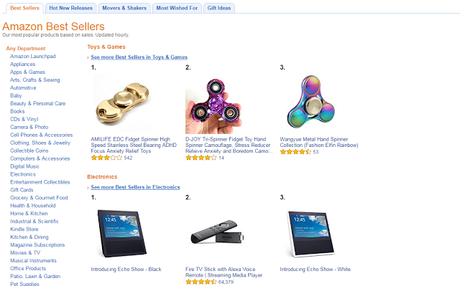 Once you find something you think would be a good topic, you're not ready to start building your website just yet.First, we need to check and make sure the market is a good "buyer" market. You want to be sure that you're choosing a topic in which people are actually spending money.The two market identification techniques (magazines, Amazon) will help narrow this down right from the outset, butnextyou want to check and see whether other people are advertising for it in Google.If there are advertisers in a market, it's a good sign that there is money being spent. Advertisers won't spend money if they're not making a profit from it, at least not for long.The next step is to use Google's keyword tool to get some ideas for "keywords" in the market - things that people are searching for on Google.The keyword tool can be found at https://adwords.google.com/o/KeywordToolEnter a general keyword for the market as shown below and click the "search" button.Let's work through an example. Say your research in the bookstore found the magazine "Cigar Aficionado" and you're thinking of targeting people who enjoy smoking cigars. Amazon has lots of products that are related - humidors, books, cutters, etc. - so there'sopportunitythere.When we run the word "cigar" through Google's keyword tool, this is what we get:
Once you find something you think would be a good topic, you're not ready to start building your website just yet.First, we need to check and make sure the market is a good "buyer" market. You want to be sure that you're choosing a topic in which people are actually spending money.The two market identification techniques (magazines, Amazon) will help narrow this down right from the outset, butnextyou want to check and see whether other people are advertising for it in Google.If there are advertisers in a market, it's a good sign that there is money being spent. Advertisers won't spend money if they're not making a profit from it, at least not for long.The next step is to use Google's keyword tool to get some ideas for "keywords" in the market - things that people are searching for on Google.The keyword tool can be found at https://adwords.google.com/o/KeywordToolEnter a general keyword for the market as shown below and click the "search" button.Let's work through an example. Say your research in the bookstore found the magazine "Cigar Aficionado" and you're thinking of targeting people who enjoy smoking cigars. Amazon has lots of products that are related - humidors, books, cutters, etc. - so there'sopportunitythere.When we run the word "cigar" through Google's keyword tool, this is what we get: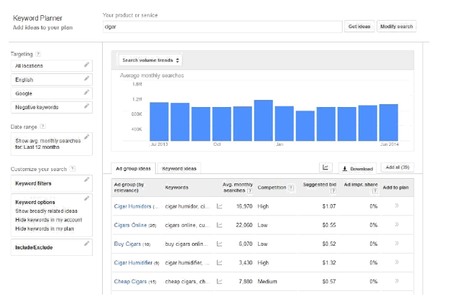 We want to order the list by the most popular, so click on the "Avg. Monthly Searches" title at the top of the third column. Now here's what we see:
We want to order the list by the most popular, so click on the "Avg. Monthly Searches" title at the top of the third column. Now here's what we see: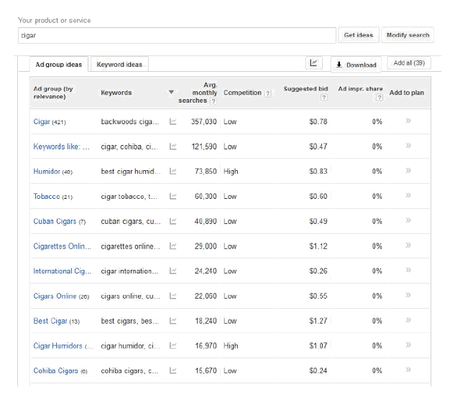 The next step in this process is to check some of these keywords (from column 2 above) to see how many people are advertising on Google. So we go to Google.com and search for several of the keywords supplied by the keyword tool.What you're looking for on Google are paid ads - the "Sponsored Ads" at the top and right side of the results.Here'sthe results we get for the above keywords at the time this report was written:* Cigar Smoking: 0 ads* Shop Cigars: 1 ad* Cigar Pipe: 0 ads * Best Cigars: 0 ads* Cigar Humidor: 3 adsThis doesn’t look like a great market to target based on those numbers, but one thing that you need to consider is that Google displays different results depending on where you’re located.This can have a bearing on how many results you see. If you don’t see many ads for something, you can change the location from the main Google search results page.Click on the “Show search tools” link and then the “Custom Location” link.
The next step in this process is to check some of these keywords (from column 2 above) to see how many people are advertising on Google. So we go to Google.com and search for several of the keywords supplied by the keyword tool.What you're looking for on Google are paid ads - the "Sponsored Ads" at the top and right side of the results.Here'sthe results we get for the above keywords at the time this report was written:* Cigar Smoking: 0 ads* Shop Cigars: 1 ad* Cigar Pipe: 0 ads * Best Cigars: 0 ads* Cigar Humidor: 3 adsThis doesn’t look like a great market to target based on those numbers, but one thing that you need to consider is that Google displays different results depending on where you’re located.This can have a bearing on how many results you see. If you don’t see many ads for something, you can change the location from the main Google search results page.Click on the “Show search tools” link and then the “Custom Location” link.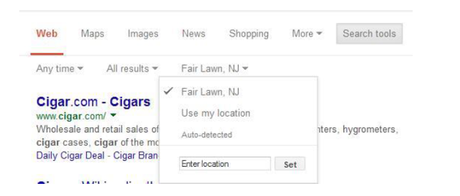 You can enter a city or country in this box to see results from that specific place.Another problem you might run into is if you’re not located in the United States,Google will default to your local version of Google. For example, in Canada, you’ll default to Google.ca when you run a search.This can skew your results because you’re going to see results that are more targeted to that country.If you want to see results from the United States instead, you can use this URL to run your Google search:http://www.google.com/intl/enIf you find a topic like this example that doesn’t have a lot of ads, and you find more by changing locations, it’s up to you whether or not to continue with it.Personally, I would move on to another alternative and run through the same process until you find one that has more advertisers in general. There’s no sense limiting your potential right out of the gate.For comparison's sake, I've run the "golf" market through the Google keyword tool and wound up with the following keywords:* Golf clubs: 11 ads * Golf equipment: 8 ads* Golf bag: 1 ad * Golf shoes: 2 ads* Golf instruction: 2 adsYou can see there are more ads here so this is a more suitable market.
You can enter a city or country in this box to see results from that specific place.Another problem you might run into is if you’re not located in the United States,Google will default to your local version of Google. For example, in Canada, you’ll default to Google.ca when you run a search.This can skew your results because you’re going to see results that are more targeted to that country.If you want to see results from the United States instead, you can use this URL to run your Google search:http://www.google.com/intl/enIf you find a topic like this example that doesn’t have a lot of ads, and you find more by changing locations, it’s up to you whether or not to continue with it.Personally, I would move on to another alternative and run through the same process until you find one that has more advertisers in general. There’s no sense limiting your potential right out of the gate.For comparison's sake, I've run the "golf" market through the Google keyword tool and wound up with the following keywords:* Golf clubs: 11 ads * Golf equipment: 8 ads* Golf bag: 1 ad * Golf shoes: 2 ads* Golf instruction: 2 adsYou can see there are more ads here so this is a more suitable market.Setting Up Your Website
Once you've picked your market and found a few products that you can promote, it's time to set up your website. There are several steps involved in this process, the first of which is to register your domain name - the address for your website.Domain Name
For these purpose-built websites, the best option for a domain name is what's known as an "exact match domain" - a domain that is the same as one of the keywords for your market.For this step, you're going to need to go back to the Google Keyword Tool and make a list of potential domain names. We want to find keywords that aren't too competitive but are still relevant to the topic and types of products you're going to promote.The keyword tool lets you narrow down your search by filtering the results.First, click on Keyword Filters on the left-hand side.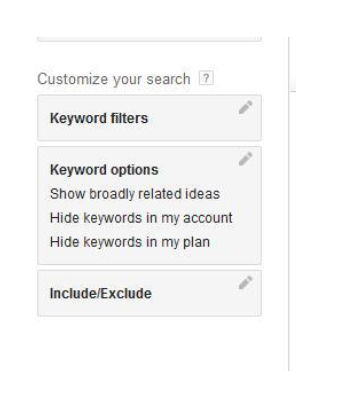 Next, under "Filter Ideas" choose Competition on the drop-down list and check Low and Medium, and for Average monthly searches choose <= 10000 searches:
Next, under "Filter Ideas" choose Competition on the drop-down list and check Low and Medium, and for Average monthly searches choose <= 10000 searches: This will narrow down the search to keywords that have low to medium competition and somewhere fewer than 10,000 searches every month. This will give you a list of keywords that have relatively low competition but still get enough searches to make it worth pursuing.Take note of any keywords in the results you get that would make a good domain. Avoid keywords with things like city names, brand names or anything else that is obviously specific to a place, person, event or other things.You also want to avoid brand names because they are usually trademarked and you could wind up in legal trouble if you use a trademark in your domain name.In our golf example, this is the list of keywords that we've come up with once we weed out all these other things:* golf drivers reviews* golf partners* golf swing basics* golf club ratings* golf swing mechanics* golf headquarters* golf equipment review* golf equipment reviews* golf gadgets* golfing newsThe next step from here is to run these keywords through a bulk domain checker, which will tell you which of them is available to register.We recommendNamecheapfor domain registrations, and you can find their bulk search toolhere:You can search up to 50 domains at a time. Take the list of keywords you came up with and copy and paste them into the search box. The only catch here is you will need to remove all the spacesfirst,since you can't havea spacein a domain name. So instead of "golf drivers reviews" you would have "golfdriversreviews.com".Click on “Search these extensions” and then go down to the bottom of the page, and click on “check all” and then “uncheck all” and then come back up and select .com, .net, and .org. We don’t want to consider any other extension.
This will narrow down the search to keywords that have low to medium competition and somewhere fewer than 10,000 searches every month. This will give you a list of keywords that have relatively low competition but still get enough searches to make it worth pursuing.Take note of any keywords in the results you get that would make a good domain. Avoid keywords with things like city names, brand names or anything else that is obviously specific to a place, person, event or other things.You also want to avoid brand names because they are usually trademarked and you could wind up in legal trouble if you use a trademark in your domain name.In our golf example, this is the list of keywords that we've come up with once we weed out all these other things:* golf drivers reviews* golf partners* golf swing basics* golf club ratings* golf swing mechanics* golf headquarters* golf equipment review* golf equipment reviews* golf gadgets* golfing newsThe next step from here is to run these keywords through a bulk domain checker, which will tell you which of them is available to register.We recommendNamecheapfor domain registrations, and you can find their bulk search toolhere:You can search up to 50 domains at a time. Take the list of keywords you came up with and copy and paste them into the search box. The only catch here is you will need to remove all the spacesfirst,since you can't havea spacein a domain name. So instead of "golf drivers reviews" you would have "golfdriversreviews.com".Click on “Search these extensions” and then go down to the bottom of the page, and click on “check all” and then “uncheck all” and then come back up and select .com, .net, and .org. We don’t want to consider any other extension.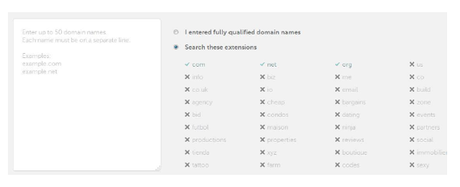 It's not always going to be this easy to find a perfect domain name, but it’s worth the effort. Sometimes you will find none of your potential domains are available and you have to do some more digging - but it's surprising how often you'll find these "hidden gems" right off the bat.If you can find a .com available, that’s best, but you could consider .net and .org names also if worst comes to worst.If none of the domains are available, it's better to go back to the keyword tool and do some more digging than to choose a less-effective extension that might be available. If you don't have a .com, .net or .org extension it makes getting traffic to your website more difficult.
It's not always going to be this easy to find a perfect domain name, but it’s worth the effort. Sometimes you will find none of your potential domains are available and you have to do some more digging - but it's surprising how often you'll find these "hidden gems" right off the bat.If you can find a .com available, that’s best, but you could consider .net and .org names also if worst comes to worst.If none of the domains are available, it's better to go back to the keyword tool and do some more digging than to choose a less-effective extension that might be available. If you don't have a .com, .net or .org extension it makes getting traffic to your website more difficult.
